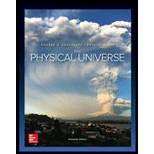
Comets
- a. follow orbits around the earth
- b. follow orbits around the sun
- c. move randomly through the solar system
- d. are the tracks left in the atmosphere by meteoroids
The movement of comets.
Answer to Problem 1MC
Option-(b)-“follow orbits around the earth.”
Explanation of Solution
Comets are the transient visitors that constitute the night sky apart from stars, planets and moon. It is mainly composed of ice and dust. Apart from this, smaller amounts of various frozen gases such as carbon monoxide, carbon dioxide, methane, ammonia, and hydrogen cyanide are also present.
The paths of comets that periodically pass near the earth are entirely different from the nearly circular planetary orbits. The orbits of comets are long and narrow and they approaches the sun from far out in space beyond Pluto, swings around the sun and then retreats. Comets returns at regular intervals.
Conclusion:
Comets approaches the sun far out in space beyond Pluto, and they swings around sun before retreats. Hence, option (b) is correct.
Comets will not follow the orbits around the Earth. Hence, option (a) is incorrect.
Comets cannot move randomly through the solar system. They returns at regular intervals only. Hence option (c) is incorrect.
Comets are not the tracks left in the atmosphere by meteoroids. Hence option (d) is incorrect.
Want to see more full solutions like this?
Chapter 17 Solutions
Physical Universe
- What is the difference between a gas tail and a dust tail? What does that tell you about the composition and origin of comets?arrow_forward2. Comet 1943 I has a period of 512 years and an eccentricity of 0.999914 and an inclination of 22 degrees. a. What is the comet's semi major axis? b. What are its perihelion and aphelion distances? c. What is the most likely source region of this object? d. What is its tisserand parameter and what does that tell you?arrow_forwardOvals, spots, and storms do not appear prominently in the atmosphere of Saturn because the a. temperature is too low. b. temperature is too high. c. atmospheric chemistry does not permit their development. d. atmosphere is too dense. e. planet’s ring system interferes with storms.arrow_forward
- The odd orbits of Nereid and Triton, which are moons of Neptune, indicate that these a. moons were captured. b. moons formed simultaneously with the planet from the same piece of the solar nebula. c. moons broke off from the rapidly rotating planet. d. moons formed as the result from a giant impact early in the planet’s history. e. orbits were disturbed long ago in an interaction with some other body.arrow_forwardThe rings of Uranus were discovered a. during an occultation (an eclipse) of a star. b. during an eclipse of one of the moons by the rings. c. during an eclipse of Uranus by the rings. d. as Uranus and the rings passed behind Jupiter. e. by the Voyager 1 spacecraft.arrow_forwardChondrites are meteorites that have a. never been heated. b. been heated sufficiently to release volatiles they contained. c. been heated sufficiently to melt the chondrules. d. been completely melted. e. entered Earth’s atmosphere but will be destroyed before reaching the ground.arrow_forward
- Saturn, as viewed through a telescope, appears as a a. spherical and heavily cratered object. b. bland and nearly featureless disk. c. disk composed of brightly colored belts and bands. d. highly elliptical and bright blue disk.arrow_forwardOn the "canteloupe" hemisphere of Neptune's moon Triton, we see channels that were carved by liquid a. water b. lava c. methane d. ammonia e. nitrogen The 2004 landing on Saturn's moon Titan was achieved by the probe called a. Galileo b. Dawn c. Voyager 1 d. Huygens e. New Horizonsarrow_forwardThe dwarf planet Pluto was discovered in 1930. Since that time, which jovian planet has completed a full revolution around the Sun? a. Jupiter b. Saturn c. Uranus d. Neptune e. More than one of the abovearrow_forward
- When tidal bulges are NOT in a direct Earth-moon line but slightly ahead of the moon, a. Earth’s gravity weakens. b. their gravitational field pulls the moon forward in its orbit, causing it to recede from Earth. c. their gravitational field pulls the moon back in its orbit, causing the moon to fall toward Earth. d. Earth’s gravity strengthens, causing the moon to orbit faster. e. the tidal bulges have no effect on the moon.arrow_forwardWhich of the following is NOT a dwarf planet? a. Pluto b. Eris c. Vesta d. Ceres e. Haumea The Earth's magnetic field keeps our planet's a. temperature from rising too much b. moon in its current orbit c. atmosphere safe from the solar wind d. spin axis from wobbling too mucharrow_forwardName Date Use the table to answer questions 13 through 15. NAME DISTANCE FROM AVERAGE ΤΥΡΕ ORBIT DIAMETER SUN (Million Miles) (Earth Days) (Miles) 3,032 TEMPERATURE ('C) Mercury 35 5,800 Terrestrial 88 Venus 67 260 Terrestrial 224 7,521 Earth 93 365 7,926 15 Terrestrial Mars 142 260 Terrestrial 687 4,222 Jupiter 484 2150 Gas 4332 88,846 74,898 31,763 Saturn 887 2170 Gas 10755 Uranus 1,784 2200 Gas 30687 Neptune 2,795 2220 Gas 60190 30,778arrow_forward
 Horizons: Exploring the Universe (MindTap Course ...PhysicsISBN:9781305960961Author:Michael A. Seeds, Dana BackmanPublisher:Cengage Learning
Horizons: Exploring the Universe (MindTap Course ...PhysicsISBN:9781305960961Author:Michael A. Seeds, Dana BackmanPublisher:Cengage Learning
